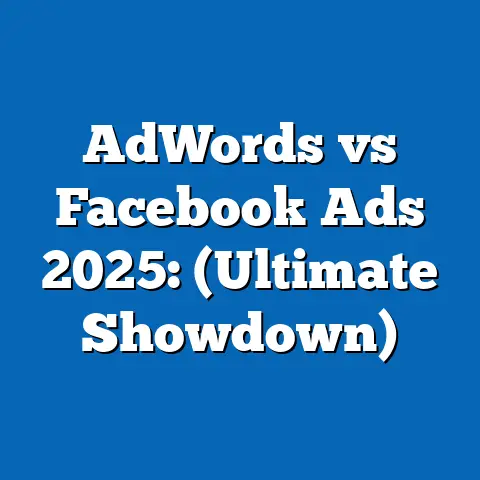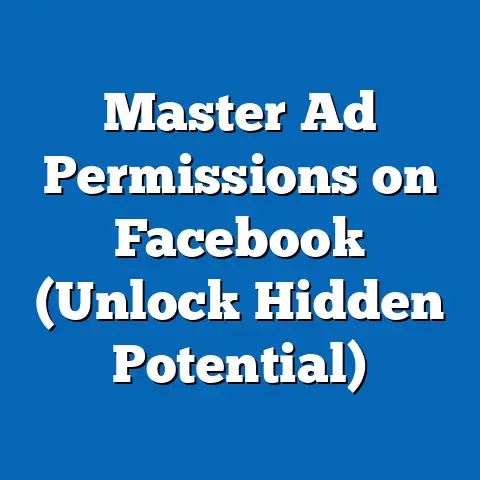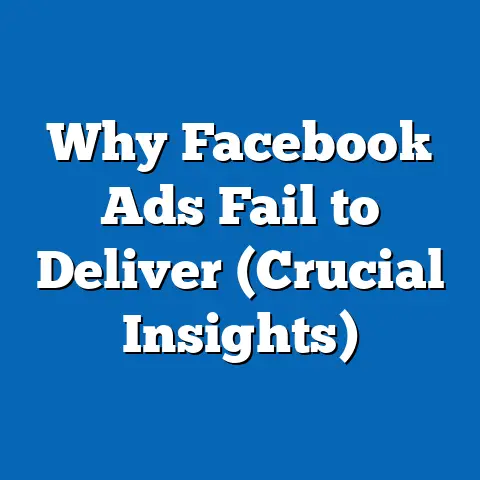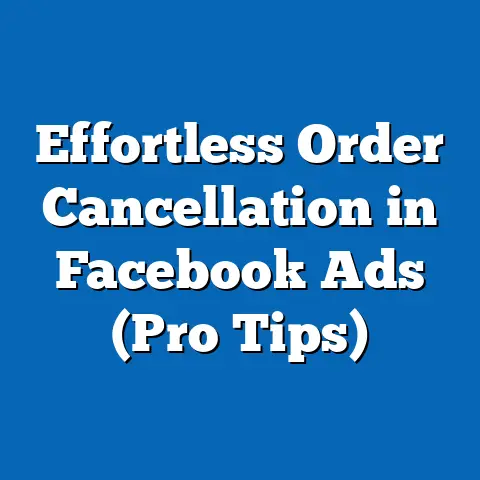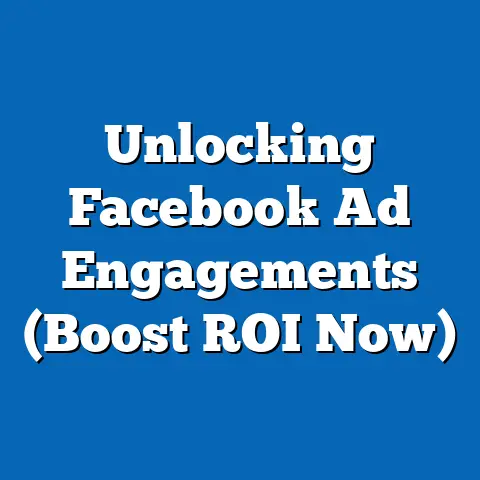Master 20% Off Facebook Ads (Proven Strategies Inside)
Are you tired of watching your Facebook ad budget drain away without seeing the returns you expect? I know I have been there. It’s a frustrating reality for many businesses today. The cost of Facebook advertising seems to be constantly climbing, making it harder than ever to maintain profitability while reaching your target audience. You pour money into campaigns, hoping to see a surge in leads or sales, but often the results are underwhelming, leaving you wondering if there’s a better way.
Believe me, I understand the struggle. I’ve seen countless businesses, including my own ventures, grapple with the rising costs of Facebook ads. It feels like you’re constantly fighting an uphill battle against increasing competition and algorithm changes. But what if I told you there’s a way to not only survive but thrive in this environment? What if you could actually slash your advertising costs by 20% or more?
That’s exactly what I’m going to show you in this article. Forget throwing money blindly at Facebook and hoping for the best. I’m going to reveal proven strategies that will help you maximize your ad efficiency, reach the right audience, and significantly reduce your costs. Think of it as unlocking a secret level in Facebook advertising – a level where you’re not just spending less, but spending smarter.
Get ready to discover the insider secrets to mastering Facebook ads and achieving that coveted 20% discount. Let’s dive in!
Understanding Facebook Ads
Before we get into the nitty-gritty of cost-saving strategies, let’s quickly recap the basics of Facebook advertising. It’s a powerful tool, but only if you understand how to wield it effectively.
Facebook offers a diverse range of ad formats to choose from, each designed to capture attention and drive engagement. You have your classic image ads, perfect for showcasing products or services with eye-catching visuals. Then there are video ads, which offer a more immersive experience and are great for storytelling or product demonstrations. Carousel ads allow you to display multiple images or videos in a single ad unit, giving you more real estate to highlight different aspects of your offering. And for a dynamic and engaging experience, slideshow ads combine images and text to create a mini-movie that can capture attention without the need for a full video production.
But choosing the right ad format is only half the battle. The real magic happens when you target the right audience. Facebook’s targeting capabilities are incredibly granular, allowing you to reach people based on demographics, interests, behaviors, and even connections. This is where the Facebook Ads Manager comes in. It’s your central hub for creating, managing, and analyzing your campaigns. Within the Ads Manager, you can define your target audience, set your budget, choose your ad placements, and track your performance.
And speaking of performance, understanding your metrics is crucial for optimizing your campaigns and driving down costs. Key metrics to pay attention to include Cost Per Click (CPC), which tells you how much you’re paying each time someone clicks on your ad; Cost Per Thousand Impressions (CPM), which measures the cost of showing your ad to 1,000 people; and Return on Ad Spend (ROAS), which shows you how much revenue you’re generating for every dollar you spend on ads.
Takeaway: Familiarize yourself with the different ad formats, master the Facebook Ads Manager, and pay close attention to your key metrics. This foundation is essential for implementing the cost-saving strategies we’ll explore next.
The Importance of Budgeting and Planning
Okay, so you know the basics of Facebook advertising. Now, let’s talk about money. Specifically, how to manage your budget effectively. I’ve seen so many businesses fail simply because they didn’t have a solid budgeting and planning strategy in place. They jump into Facebook ads without a clear understanding of their goals, their target audience, or how much they’re willing to spend. The result? Wasted money and disappointing results.
A well-planned budget is the bedrock of any successful Facebook ad campaign. It’s not just about setting a daily or lifetime spending limit; it’s about aligning your budget with your overall business goals. What are you trying to achieve with your Facebook ads? Are you looking to generate leads, drive sales, increase brand awareness, or something else? Once you have a clear understanding of your objectives, you can start to allocate your budget accordingly.
It’s also crucial to set realistic goals. Don’t expect to become a millionaire overnight with a $100 ad budget. Be realistic about what you can achieve with your resources and set targets that are both challenging and attainable. A good starting point is to research industry benchmarks for your specific niche. What’s the average CPC, CPM, and ROAS for businesses similar to yours? This will give you a realistic expectation of what you can achieve and help you set a budget that allows for experimentation and scaling.
And this brings us to the concept of the 20% discount. I see it as a mindset. It’s about approaching your Facebook ads with a focus on efficiency and cost-effectiveness. By implementing the strategies I’m about to share, you can not only reduce your overall ad spend but also improve your results. In essence, you’re getting more bang for your buck, effectively achieving that coveted 20% discount.
Takeaway: Treat your Facebook ad budget like a precious resource. Set realistic goals, research industry benchmarks, and approach your campaigns with a focus on efficiency and cost-effectiveness. This will set the stage for achieving that 20% discount.
Here are the proven strategies I’ve used to achieve significant cost savings on Facebook ads, often exceeding that 20% mark.Strategy 1: Audience Segmentation
Facebook’s audience segmentation tools are a goldmine for savvy advertisers. I can’t stress enough how important it is to understand your audience and tailor your ads to their specific needs and interests. Instead of casting a wide net and hoping to catch a few fish, audience segmentation allows you to target your ads with laser precision, increasing engagement and lowering costs.
Think about it: would you rather show a generic ad to a million people, or a highly relevant ad to a thousand people who are genuinely interested in your product or service? The latter, of course! That’s the power of audience segmentation.
Facebook allows you to segment your audience based on a wide range of factors, including:
- Demographics: Age, gender, location, education, job title, etc.
- Interests: Hobbies, passions, favorite brands, etc.
- Behaviors: Online activity, purchase history, device usage, etc.
- Connections: People who like your page, attend your events, or use your app.
- Custom Audiences: People who have interacted with your website, email list, or other marketing channels.
- Lookalike Audiences: People who share similar characteristics with your existing customers.
Let me give you an example. Let’s say you’re selling organic skincare products. Instead of targeting everyone who’s interested in “beauty,” you could create a highly targeted segment based on:
- Demographics: Women aged 25-45, located in urban areas, with a college degree.
- Interests: Organic skincare, natural beauty, vegan products, sustainable living.
- Behaviors: Frequent online shoppers, interested in eco-friendly brands.
- Custom Audience: People who have visited your website and viewed your organic skincare products.
By targeting this specific segment, you’re more likely to reach people who are genuinely interested in your products, leading to higher engagement rates, lower CPC, and ultimately, a better ROAS.
Takeaway: Dive deep into Facebook’s audience segmentation tools and create highly targeted segments based on demographics, interests, behaviors, and connections. The more relevant your ads are to your audience, the lower your costs will be.
Strategy 2: A/B Testing
A/B testing, also known as split testing, is the secret weapon of every successful Facebook advertiser. It’s the process of testing different versions of your ads to see which performs best. I’ve seen firsthand how A/B testing can dramatically improve your ad performance and reduce your costs.
The beauty of A/B testing is that it takes the guesswork out of advertising. Instead of relying on your gut feeling or intuition, you can use data to make informed decisions about your ad strategy.
You can A/B test just about anything, including:
- Ad Creatives: Different images, videos, or ad formats.
- Ad Copy: Different headlines, body text, or calls to action.
- Targeting: Different audience segments.
- Placements: Different ad placements on Facebook and Instagram.
- Bidding Strategies: Different bidding options.
The key is to test one variable at a time. For example, if you want to test different headlines, keep everything else the same (ad creative, targeting, placements, etc.) and only change the headline. This will allow you to isolate the impact of the headline and determine which version performs best.
Once you’ve run your A/B test, analyze the results and identify the winning version. Then, use that version as your control and test another variable. This iterative process will help you continuously optimize your ads and drive down your costs.
Takeaway: Make A/B testing a core part of your Facebook ad strategy. Test different versions of your ads to see which performs best and continuously optimize your campaigns based on data.
Strategy 3: Remarketing Campaigns
Remarketing is one of the most cost-effective strategies in the Facebook advertising arsenal. It involves targeting users who have already engaged with your brand, whether it’s by visiting your website, watching your videos, or interacting with your social media posts. I’ve consistently seen higher conversion rates and lower costs with remarketing campaigns compared to targeting cold leads.
Think about it: these are people who are already familiar with your brand and have shown some level of interest in your products or services. They’re much more likely to convert than someone who’s never heard of you before.
You can create remarketing audiences based on a variety of factors, including:
- Website Visitors: People who have visited specific pages on your website.
- Video Viewers: People who have watched a certain percentage of your videos.
- Lead Forms: People who have filled out a lead form on your website or Facebook page.
- Customer List: People who are already customers of your business.
- App Users: People who have downloaded and used your mobile app.
For example, you could create a remarketing audience of people who have visited your product page but haven’t added the product to their cart. You could then show them an ad highlighting the benefits of the product and offering a special discount to encourage them to complete their purchase.
Takeaway: Implement remarketing campaigns to target users who have already engaged with your brand. These warm leads are much more likely to convert, leading to higher ROI and lower costs.
Strategy 4: Optimizing Ad Placements
Facebook offers a variety of ad placement options, including:
- Facebook Feed: The main news feed on Facebook.
- Instagram Feed: The main feed on Instagram.
- Facebook Marketplace: The marketplace where people buy and sell items.
- Facebook Right Column: The right-hand column on Facebook (mostly visible on desktop).
- Instagram Explore: The explore page on Instagram.
- Facebook Stories: Short-form videos and images that disappear after 24 hours.
- Instagram Stories: Short-form videos and images that disappear after 24 hours.
- Audience Network: A network of third-party apps and websites that display Facebook ads.
Not all placements are created equal. Some placements are more effective than others, depending on your target audience, ad format, and campaign goals. I’ve found that testing different placements and optimizing your ad delivery can significantly reduce your costs and improve your results.
For example, if you’re running a video ad, you might find that it performs better on Instagram Stories than on the Facebook Feed. Or if you’re targeting a younger audience, you might want to focus on placements on Instagram and TikTok (through the Audience Network).
Takeaway: Experiment with different ad placements and optimize your ad delivery to focus on the placements that are most effective for your target audience and campaign goals.
Strategy 5: Utilizing Lookalike Audiences
Lookalike audiences are one of Facebook’s most powerful targeting tools. They allow you to reach new customers who are similar to your existing ones. I’ve used lookalike audiences to expand my reach and generate high-quality leads at a fraction of the cost of targeting cold audiences.
Facebook creates lookalike audiences by analyzing the characteristics of your existing customers, such as demographics, interests, and behaviors. It then identifies other Facebook users who share similar characteristics and creates a new audience based on those similarities.
You can create lookalike audiences based on a variety of sources, including:
- Customer List: A list of your existing customers.
- Website Visitors: People who have visited your website.
- Page Likes: People who have liked your Facebook page.
- App Users: People who have downloaded and used your mobile app.
The key to success with lookalike audiences is to use a high-quality source audience. The more accurate and representative your source audience is, the better your lookalike audience will be.
Takeaway: Leverage lookalike audiences to reach new customers who are similar to your existing ones. This can be a highly cost-effective way to expand your reach and generate high-quality leads.
Strategy 6: Leveraging Seasonal Trends
Capitalizing on seasonal trends and events can be a great way to create timely ads that resonate with your audience and drive down costs. I’ve seen campaigns that leverage seasonal trends achieve significantly higher engagement rates and lower CPC compared to generic ads.
Think about it: people are naturally more receptive to ads that are relevant to their current situation. If it’s Valentine’s Day, they’re more likely to be interested in ads for flowers, chocolates, or romantic getaways. If it’s Black Friday, they’re more likely to be interested in ads for discounted products.
You can leverage seasonal trends by:
- Creating ads that feature seasonal imagery and messaging.
- Offering special discounts and promotions for seasonal events.
- Targeting your ads to people who are interested in seasonal activities.
For example, if you’re selling winter clothing, you could create ads that feature snowy landscapes and cozy sweaters. You could also offer a special discount for the holiday season and target your ads to people who are interested in skiing, snowboarding, or other winter sports.
Takeaway: Capitalize on seasonal trends and events to create timely ads that resonate with your audience. This can be a great way to increase engagement and drive down costs.
Measuring Success and Adjusting Strategies
No matter how well you plan your Facebook ad campaigns, it’s essential to track your performance and adjust your strategies accordingly. The world of Facebook advertising is constantly evolving, and what worked yesterday might not work today. I’ve learned that the key to long-term success is to be agile and adaptable.
Facebook Insights and other analytical tools provide a wealth of data about your ad performance, including:
- Impressions: The number of times your ad was shown.
- Reach: The number of unique people who saw your ad.
- Clicks: The number of times people clicked on your ad.
- CPC: The cost per click.
- CPM: The cost per thousand impressions.
- Conversion Rate: The percentage of people who completed a desired action, such as making a purchase or filling out a lead form.
- ROAS: The return on ad spend.
By tracking these metrics, you can identify successful strategies that are leading to cost savings and improved results. You can also identify campaigns that are underperforming and need to be adjusted.
For example, if you notice that your CPC is higher than usual, you might want to try testing different ad creatives or targeting different audience segments. Or if you notice that your conversion rate is low, you might want to review your landing page or offer a special discount to encourage people to complete their purchase.
Takeaway: Continuously track your ad performance and adjust your strategies based on data. The more agile and adaptable you are, the more successful you’ll be in the long run.
Conclusion
Mastering Facebook ads is not just about spending less; it’s about spending smarter. By implementing the proven strategies I’ve shared in this article, you can achieve that coveted 20% discount on your Facebook advertising costs, ultimately leading to greater business growth and success.
Remember, the key is to:
- Understand your audience and target your ads with laser precision.
- Continuously A/B test different versions of your ads.
- Leverage remarketing campaigns to target warm leads.
- Optimize your ad placements to focus on the most effective channels.
- Utilize lookalike audiences to reach new customers who are similar to your existing ones.
- Capitalize on seasonal trends and events to create timely ads.
- Track your performance and adjust your strategies based on data.
So, what are you waiting for? Start implementing these strategies today and watch your Facebook ad costs plummet while your results soar!

